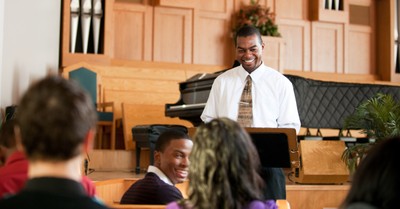America the Beautiful: What's the Story?
- Ernest K. Emurian Author of Living Stories of Famous Hymns
- Published Jun 28, 2001

Every school child knows that “Columbus sailed the ocean blue in fourteen-hundred and ninety-two.” But very few of them know that the celebration of the four-hundredth anniversary of his discovery inspired a school teacher to write one of our noblest patriotic hymns.
In connection with this nation-wide observance, the city of Chicago sponsored the Columbian Exposition, a World’s Fair of yesterday, which ran continuously for several years. On the site of the Exposition magnificent buildings were erected. Every structure designed by Daniel Burnham was a masterpiece of planning, construction and beauty. Thousands of people came from all over the world to marvel at the splendor and stand enraptured before the grandeur of such a spectacle.
In the early summer of 1893, while the Exposition was still in full swing, a group of teachers and professors from Wellesley, a famous girls’ college, stopped off in Chicago enroute to Colorado. Among them was thirty-four-year-old Katharine Lee Bates, holder of a Master’s Degree from Oxford, and a professor of English. The young women were profoundly impressed by all they saw in and about “The Windy City”; but they soon left Lake Michigan behind them as they continued their journey westward. Once in Colorado, they made the trip up the famous peak which was named for the American general who discovered it about 1806, Zebulon Montgomery Pike. From the summit, which towers more than fourteen-thousand feet above sea level, Miss Bates “gazed in wordless rapture over the expanse of mountain ranges and the sealike sweep of the plains” that stretched before her for hundreds of miles until they seemed to melt into the misty blue of heaven.
Later that evening, the teachers were talking over the events of the day in the home in which they were staying in Colorado Springs. The discussion naturally included a comparison of the Exposition, a man-made spectacle, with the Rocky Mountains and the view from Pike’s Peak, fashioned by the hand of God. Miss Bates suggested that “unless we crown our good with brotherhood, of what lasting benefit are our spacious skies, our amber waves of grain, our mountain majesties or our fruited plains.” She added, “We must match the greatness of our America with the goodness of personal godly living.” Soon the teachers were comparing the land of their day with the America of the Pilgrims and the Jamestown settlers of 1607. They spoke of the two stones that played important parts in the nation’s history; the Ten Commandments and Plymouth Rock, and agreed that if their fellow-citizens could couple the daring of the Pilgrims with the moral teachings of Moses, together with the ability of them both to venture into uncharted seas, they would really have something in this country that no one could ever take from them.
They mentioned the heroes and heroines of the past, from Molly Pitcher to Barbara Fritchie, and felt that it is more difficult to be a living hero in one’s own day than to revere a dead hero from a former day. When one teacher showed the group a small piece of alabaster she had purchased in a souvenir shop, the others talked about “the alabaster city” where all would be joy and peace, and where people would live together with their eyes undimmed by human tears. Later that night, with the events of the trip vividly in her mind, Miss Bates sat down and expressed her dream of a Christian nation in these words:
Before she laid her pen down she had written four stanzas, each closing with a prayer for her beloved America. The stanzas were not printed until two years after they were written. In the July 4, 1895 issue of “The Congregationalist” they appeared for the first time outside of her own private notebook. Quickly they were accepted, quoted, and widely acclaimed as an expression of Christian patriotism at its highest and best. Of the many musical settings, one has endured – the hymn tune “Materna” which Samuel A. Ward composed for the hymn “O Mother Dear Jerusalem.” Today this tune and her stanzas are wedded in the hearts of the American people.
The author was honored with degrees from many colleges and universities. During her forty-five years as a professor and before her death in 1929, she wrote seventeen books. But she is loved and honored today as the author of one of the nation’s finest patriotic hymns. If the celebration of the four-hundredth anniversary of the discovery of America did no more than inspire Rev. Francis Bellamy to write the original “Pledge of Allegiance to the Flag” and Katharine Lee Bates to write “America the Beautiful” it was eminently worthwhile. Because the Pledge and the Poem will live as long as America lives.
Excerpted from Living Stories of Famous Hymns. Click here to purchase book at CBD.
Return to Crosswalk.com's Homepage
Return to Crosswalk.com's Spiritual Life Channel
In connection with this nation-wide observance, the city of Chicago sponsored the Columbian Exposition, a World’s Fair of yesterday, which ran continuously for several years. On the site of the Exposition magnificent buildings were erected. Every structure designed by Daniel Burnham was a masterpiece of planning, construction and beauty. Thousands of people came from all over the world to marvel at the splendor and stand enraptured before the grandeur of such a spectacle.
In the early summer of 1893, while the Exposition was still in full swing, a group of teachers and professors from Wellesley, a famous girls’ college, stopped off in Chicago enroute to Colorado. Among them was thirty-four-year-old Katharine Lee Bates, holder of a Master’s Degree from Oxford, and a professor of English. The young women were profoundly impressed by all they saw in and about “The Windy City”; but they soon left Lake Michigan behind them as they continued their journey westward. Once in Colorado, they made the trip up the famous peak which was named for the American general who discovered it about 1806, Zebulon Montgomery Pike. From the summit, which towers more than fourteen-thousand feet above sea level, Miss Bates “gazed in wordless rapture over the expanse of mountain ranges and the sealike sweep of the plains” that stretched before her for hundreds of miles until they seemed to melt into the misty blue of heaven.
Later that evening, the teachers were talking over the events of the day in the home in which they were staying in Colorado Springs. The discussion naturally included a comparison of the Exposition, a man-made spectacle, with the Rocky Mountains and the view from Pike’s Peak, fashioned by the hand of God. Miss Bates suggested that “unless we crown our good with brotherhood, of what lasting benefit are our spacious skies, our amber waves of grain, our mountain majesties or our fruited plains.” She added, “We must match the greatness of our America with the goodness of personal godly living.” Soon the teachers were comparing the land of their day with the America of the Pilgrims and the Jamestown settlers of 1607. They spoke of the two stones that played important parts in the nation’s history; the Ten Commandments and Plymouth Rock, and agreed that if their fellow-citizens could couple the daring of the Pilgrims with the moral teachings of Moses, together with the ability of them both to venture into uncharted seas, they would really have something in this country that no one could ever take from them.
They mentioned the heroes and heroines of the past, from Molly Pitcher to Barbara Fritchie, and felt that it is more difficult to be a living hero in one’s own day than to revere a dead hero from a former day. When one teacher showed the group a small piece of alabaster she had purchased in a souvenir shop, the others talked about “the alabaster city” where all would be joy and peace, and where people would live together with their eyes undimmed by human tears. Later that night, with the events of the trip vividly in her mind, Miss Bates sat down and expressed her dream of a Christian nation in these words:
O beautiful for spacious skies, For amber waves of grain;
For purple mountain majesties, Above the fruited plain.
America! America! God shed His grace on thee;
And crown thy good with brotherhood, From sea to shining sea.
Before she laid her pen down she had written four stanzas, each closing with a prayer for her beloved America. The stanzas were not printed until two years after they were written. In the July 4, 1895 issue of “The Congregationalist” they appeared for the first time outside of her own private notebook. Quickly they were accepted, quoted, and widely acclaimed as an expression of Christian patriotism at its highest and best. Of the many musical settings, one has endured – the hymn tune “Materna” which Samuel A. Ward composed for the hymn “O Mother Dear Jerusalem.” Today this tune and her stanzas are wedded in the hearts of the American people.
The author was honored with degrees from many colleges and universities. During her forty-five years as a professor and before her death in 1929, she wrote seventeen books. But she is loved and honored today as the author of one of the nation’s finest patriotic hymns. If the celebration of the four-hundredth anniversary of the discovery of America did no more than inspire Rev. Francis Bellamy to write the original “Pledge of Allegiance to the Flag” and Katharine Lee Bates to write “America the Beautiful” it was eminently worthwhile. Because the Pledge and the Poem will live as long as America lives.
Excerpted from Living Stories of Famous Hymns. Click here to purchase book at CBD.
Return to Crosswalk.com's Homepage
Return to Crosswalk.com's Spiritual Life Channel




















